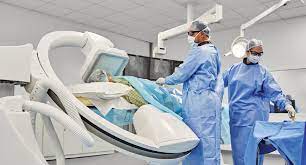Kumaran Hospitals and Rela Institute launched an Artificial Intelligence-based Cath lab. The Innova IGS 5 with auto right with advanced visualization and multipurpose applications will provide fine image details simultaneously on cross-sections and volume-rendered to help you clearly visualize vessels, small devices, and soft tissues. Ravi Appaswamy and Dr Ishari Ganesh launched the lab in the presence of Prof Mohammed Rela, chairman, Rela Hospital.
The AI-powered Cath lab will help the healthcare providers in a variety of procedures such as cardiovascular, electrophysiology, oncology, and neuro interventions procedures and it will provide the image clarity which will enable the physicians to deliver proactive, pre-emptive, and preventive care for at-risk individuals, improving lives increase clinical confidence. The Innova IGS 5 is fully automated image optimization that helps remove the burden of manual adjustment. Automation can make image quality and dose optimization fast, accurate, and repeatable.
“This is an extremely advanced technology that would immensely help the clinicians add greater precision to their works. I am, personally, very happy that this technology is made available in Kumaran Hospitals. Being the first Artificial Intelligence-enabled Cath lab in Chennai, in a way, it’s actually an additional pair of eyes to the physicians, it really helps interpreting intravascular images and it provides immediate feedback on how to proceed with a case based on the current guidelines and clinical evidence. Kumaran Hospitals and Rela Institute have been and shall continue to stay committed in introducing world-class healthcare tech leading to enhanced delivery of patient care services at the most affordable cost,” said Prof Rela.
Dr Shiva, MD, Kumaran Hospital, said, “Innova IGS 5 with the auto right is the first such machine in Tamil Nadu with artificial intelligence from GE and it has loaded with inbuild software including CT scan, which will give hassle-free services to the patients. This machine is a big boon for diabetic people as it will enhance the physicians to see the smallest blood vessels of the patients to avoid gangrene. The AI-powered Cath lab will be available for patients at no extra costs.”
For angiogram, angioplasty or ablation, the skin at either your groin, collarbone or neck will be cleaned using a special solution, before a local anesthetic is administered by injection to numb the site. The cannula is then inserted, and the catheters are passed through the vein or artery to your heart, using x-ray guidance.
During an angioplasty, the catheter will be directed until its tip reaches a narrow or blocked section of coronary artery. A balloon on the end of the catheter is then gently inflated so that it squashes the fatty plaques – or deposits – against the artery wall, widening the artery and allowing the blood to flow more easily. Often a stent, a thin tube of expandable mesh, will be inserted to reinforce the walls of the artery.
After the procedure, the catheter will be removed and you might have a small amount of bleeding. If so, the nurse or doctor will press on the cut for a little while or insert a plug called an Angio seal.
You might be asked to stay lying down afterwards – probably for just a short time after an angiogram, or a few hours after an ablation.
You can usually go home the same day as your angiogram. If you’ve had an angioplasty, ablation or pacemaker or ICD implantation, it could be the same day or the next day. If you’ve had an emergency angioplasty for a heart attack you will need to stay in hospital a little longer.
If you like our post Please share your feedback in the comment section below. Please like our page on Facebook, Instagram, and LinkedIn also.
Please do check out our services.


